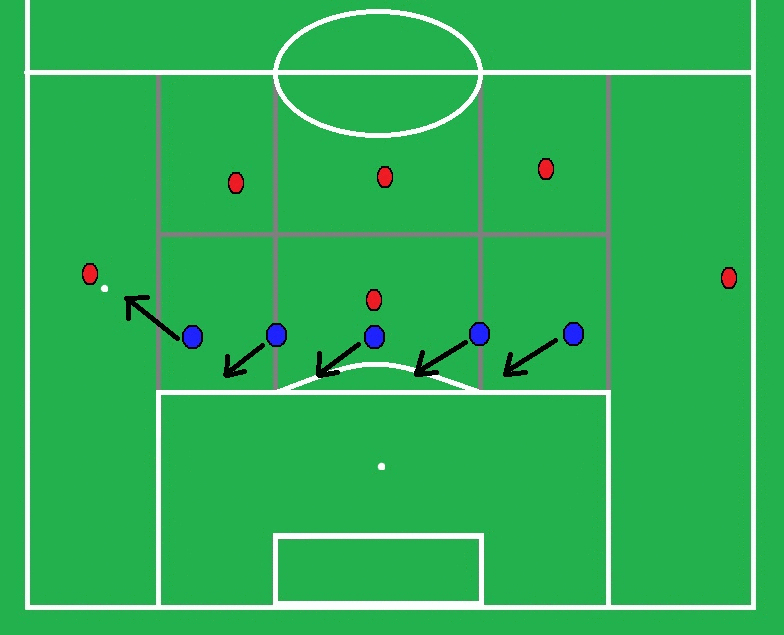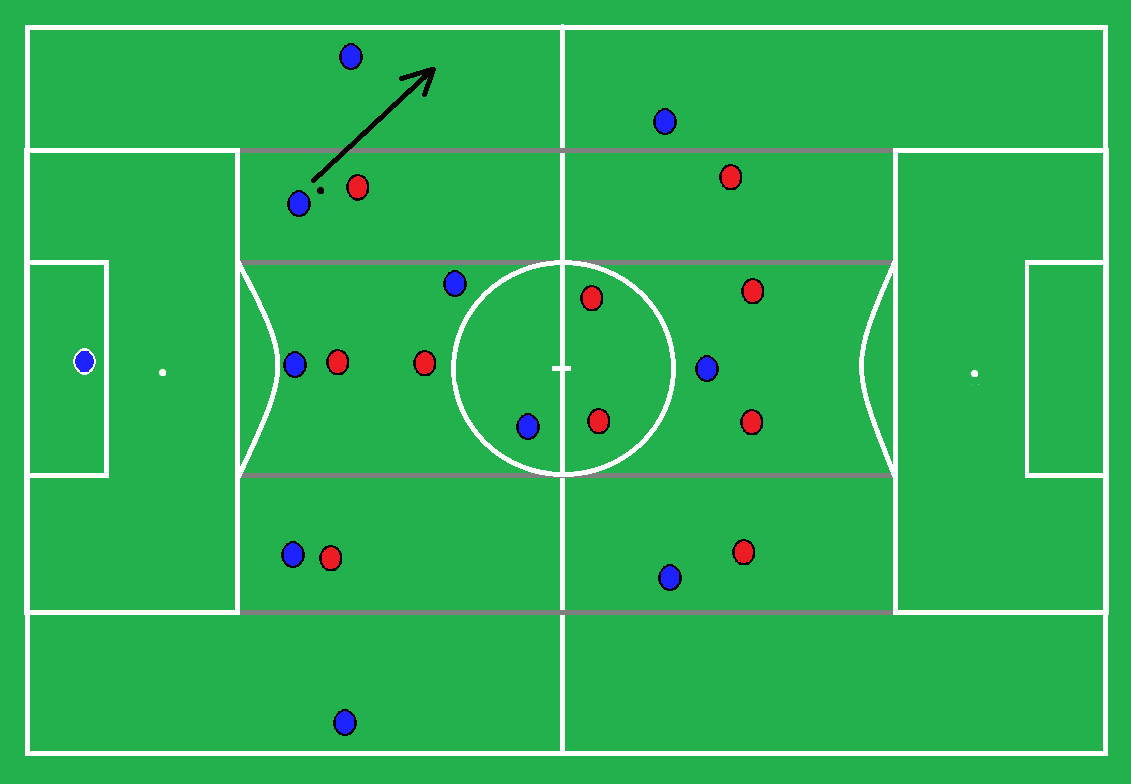The Benefits of Playing a Back 3
This is a look at playing a back 3, both in possession and without. Looking at why it is coming back in vogue, with more and more teams playing with a back 3.
First, we must define what we will be focusing on. That will be teams that play with 3 players in the middle at the back. This Excludes when a midfielder drops in between 2 centre backs, Sergio Busquets at Barcelona. Or when 1 fullback pushes forward in attacking phase eg: Tottenham under Jose Mourinho. Thus, we will be mainly focusing on the 3-5-2, 3-4-3, 3-4-2-1 and 3-6-1 formations. Although a lot of these are quite similar with player rotations in the forward half, we will focus on the back 3 wingbacks and holding midfielders, #6’s and #4’s depending on which part of the world you’re from.
For the purposes of illustration I will use the 3-4-3 system as a guide.
Defending with a back 3
First, we will look at Defending against teams that play with 3 attackers (4-3-3, 4-2-3-1 primarily)
Without the ball it seems like it will be 1v1 across the back but combine that with wingbacks and its 5 v 3 in your backline. Here is the tricky part some teams play with wingers; others play with inside forwards.


In both situations you can see that we have a numerical advantage in our back line. The situation on the left will allow the outside centre back to be able to help with the winger if he chooses to come inside. And allows them to press in a central area if a midfielder is carrying the ball through the “halfspace”. The situation on the right allows the wing backs to press forward on a ball carrier down the wing, while also allowing them to be able to press down and create the 2v1 in the middle. This is quite a basic way of looking at things. But it gives an idea of the numbers game.
The 3/5 at the back is especially effective when the ball is in wide areas it allows for a man on man approach in the last 3rd while also creating a man free to “sweep” or cover if a 1v1 duel is lost.

If we layer on top of the back 3 the holding midfielders, we can see that a lot of passing lanes into the opposition forward players are blocked, reducing the threat that they pose.

Of course, playing against a 4-2-3-1 there will be a #10 in position usually behind our midfield 2. To combat this we can have our closest centre back leave their man, to go pressure the 10, as well as have a midfielder close from their position, giving us multiple angles of pressure to reduce the chances of them been able to make a play. We can also have our spare centre back pick up the free man who our centre back just left.

Against a front 2, the match ups are slightly easier, as we don’t need many rotations or player change overs to match up, especially against a 4-4-2, which more and more teams are starting to play.

As you can see we still have a man advantage in our back line, as our wing backs are matched up vs opposition wingers. This means that the ability for double marking and player swaps is greatly diminished with just the back 5. This relies heavily on timing and excellent skills in defending 1v1 situations.
Again layering the midfielders in to the picture a flat 4-4-2, we see that a man-to-man marking system is the easiest way to be able to match up and ensure that the opposition are unable to receive the ball in space.

The issue with playing this way is that a good touch or piece of skill by the attacking team and the system is broken down, and without training the counter moves and the player rotations if there is an opposition player running free it is harder to execute. A lot relies on the intelligence of the middle centre back.
Another way to defend with a back 3, doesn’t really rely on the opposition too much, and that is to play zonally eg: Antonio Conte with his current Inter Milan team. To achieve this each player takes up pre-arranged positions in relation to the ball and other teammates.
** for illustration purposes I have left the midfield lines out, but of course the centre back charging the midfielder in image 3 would close the nearest midfielder.

Playing out and progressing forward
The main idea for playing out with a back 3 is to be able to get one of the centre backs to pass the ball to a free midfielder, or carry the ball pass an opponent and utilize gaps in the opponent pressing scheme.
First, we will look at playing out against a front 3
Like when defending against a front 3 we can create an advantage in 2 ways;
1) by utilising the wing backs,
2) by utilising the holding midfielder(s).
Utilising wing backs
Utilising the wingbacks vs a front 3 makes that front 3 defend the full width of the pitch, it allows your midfielders to both play a little bit higher dragging the opposition midfield back with them, giving more space for that 5 to operate in.

To keep this at one of the most basic moves we can use a centre back and wig back to isolate a winger. And working the 2 v 1 situation we created to progress along the one side of the pitch.

Or with the same first ball (centre back to winger) we can play a switch to the far side centre back or wing back.

Playing out vs a front 2.
During the first phase of build up the yellow zone. We need to try and stretch the opponent. Against a front 2 this can be done in 2 ways.
1) by still having the wing backs in a shallower position in relation to the centre backs, this means that either the front 2 have to try and defend 5 of our players or, the midfielders for the opposition have to come forwards and press onto the wing backs, leaving space for the wingers and midfielders to exploit wide.
OR
2) Push the wing backs higher to pin back the opposition midfielders and split the centre backs wider. This makes the opposition front 2 have to defend more ground, and in conjunction with our goalkeeper we still have a 4 v 2 in our first phase of build-up.
Both these options can create different spaces for us to attack. When to use which one is normally dependent on what pressing scheme the opposition are playing.


Utilising midfielders in the first phase.
Utilising the midfielders in the first phase of build up is what you would normally see from a team playing 3-4-3. This is that the wing backs push high into the middle or attacking 3rds and that the 2 central midfielders will drop close to the last 3rd to help with build-up.
When utilising the midfielders you will see similarities in the way that we set up playing against a 4-4-2 with the centre backs split wider, but as this is a tactic usually reserved for playing against a front 3, they will take up ever so slightly different positions.
Vs a front 3

When trying to use the midfielders in the first phase, it is important to stretch the front 3 as much as possible. This allows for a bigger passing lane into the midfielders. It is important to also look past the opposition front 3 and towards their attacking midfielder (in a 4-2-3-1), as he will inevitably join the press and mark 1 of the midfielders, thus leaving a spare midfielder for us to play to.
Vs a front 2
Playing out against a front 2 using the central midfielders is quite an easy task, as with MOST 4-4-2’s the central midfielders will be reluctant to press, therefore we should have a 5 v 2 situation at the back. The strikers will tend to drop onto or shade our midfielders. That will open the middle of the field for central runs behind the line of their strikers.

As with all of these examples, it is important to note when these movements are able to be conducted. I have only explored the short passing motions within the first phase of build-up. If these are unable to be conducted, it means that a more direct pass to one of the front 3 will be on.
















